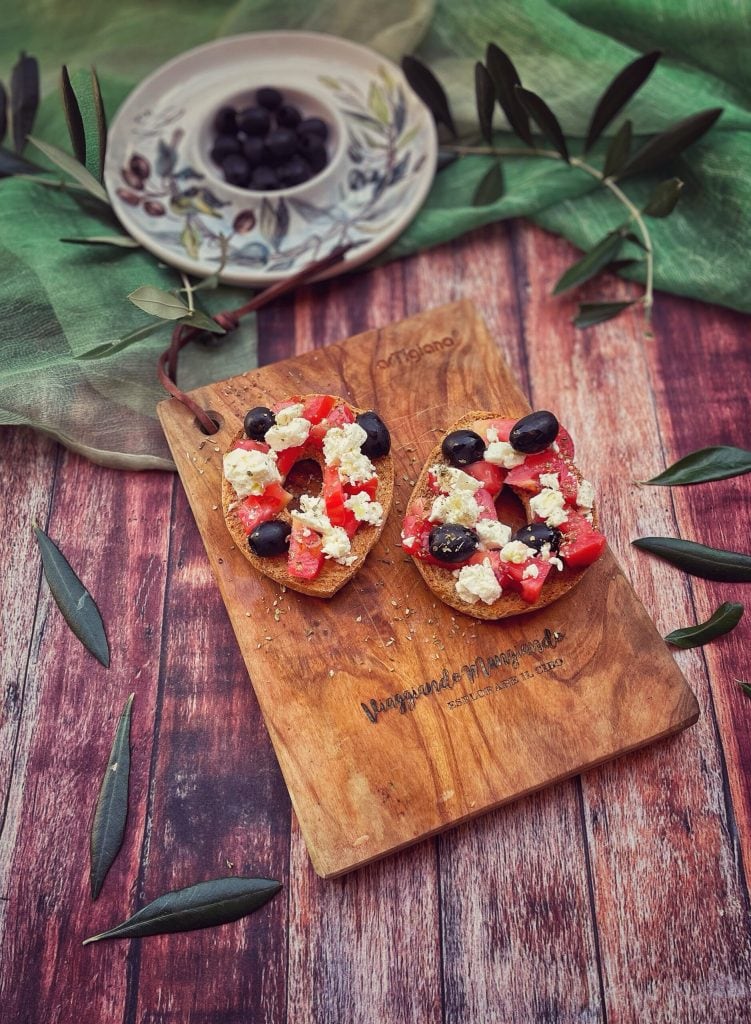The dakos (or ntakos), also known as koukouvagia (κουκουβάγια), is a traditional Cretan dish: a slice of hard barley bread called paximadi, similar to the Neapolitan fresella, moistened and topped with fresh tomatoes, cheese, usually feta or mizithra (typical of Crete and made with sheep’s or goat’s milk and whey), olive oil, oregano, and sometimes olives or capers.
The paximadi (or paximathia, plural) is a type of hard bread, similar to a rusk, originating from Greece, and is often made with whole grain, chickpea, or barley flour; baked twice and then dried, becoming very hard.
The version called ntakos, round with barley flour, is specific to the island of Crete; the one made with chickpeas is known as eptazymo or eftazymo.
Another variety of paximadi is called:

- Difficulty: Easy
- Cost: Economical
- Preparation time: 10 Minutes
- Portions: 2 People
- Cooking methods: No cooking
- Cuisine: Greek
- Seasonality: Spring, Summer, All seasons
Ingredients
- 2 slices paximathia (or freselle)
- 2.8 oz feta (or mizithra)
- 1 tomato
- to taste olive oil
- to taste Kalamata olives
- to taste oregano
- to taste salt and pepper
Steps
If using paximadi, moisten it slightly by running it under cold water for a few seconds, then let it rest on a plate.
Cut the tomatoes and season them with oil, salt, and oregano.
Drizzle the oil over the paximadi, then add the tomatoes, cheese, and olives.
Season again with oil and a pinch of pepper.

You can purchase the personalized cutting board on the Affetta Tartufi Tenderni website with my discount code SELENE10.
If you want to use Italian extra virgin olive oil, you can purchase it on the website: www.oliotreregine.it 10% discount with code selene10.
FAQ
What is the recipe for paximadi?
If you want to prepare barley paximadi, here is the recipe, you can alternatively use freselle, whose recipe can also be found on the blog.
650 g barley flour
250 g wholemeal flour
700 ml water (at room temperature)
4 g dry yeast
2 tablespoons olive oil
30 g honey
16 g salt
15 g olive oil
Put the white flour, yeast, and 250 g of lukewarm water in a bowl, mix until a thick batter is obtained. Let rise covered with plastic wrap in a warm place until doubled.
In the mixer bowl, put the leavened mixture, then add the sifted barley flour, honey dissolved in a little water, and start kneading, gradually adding the remaining water.
When the dough starts to thicken, add the salt, knead a little more, and add the extra virgin olive oil.
Continue working it until it becomes soft and elastic, and it detaches from the sides of the bowl.
After kneading, form a ball, transfer it to an oiled bowl, and let it rise covered with plastic wrap until it doubles.
Once doubled, transfer the dough to a work surface, divide it into pieces (about 120-140 g),
With each portion, form long sausages and roll each into itself creating a spiral.
Place the spirals on a baking sheet lined with parchment paper and let rise again until doubled.
At this point, proceed with the first baking in a preheated oven (static) at 180°F for 20 minutes.
When the paximathia are warm, cut them in half and return them to the oven (to toast) at 170°F for 30/40 minutes, or until golden and dry.
After the second baking, paximathia can be stored in sealed containers for a long time.

